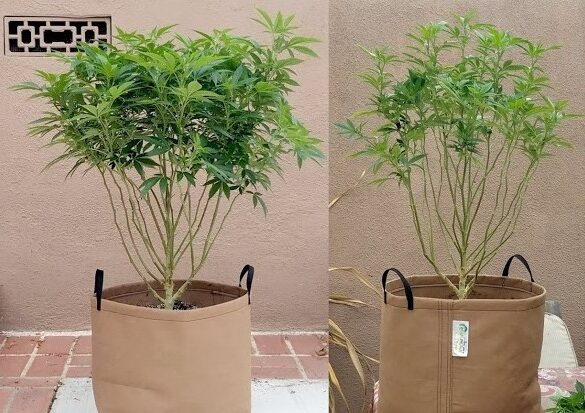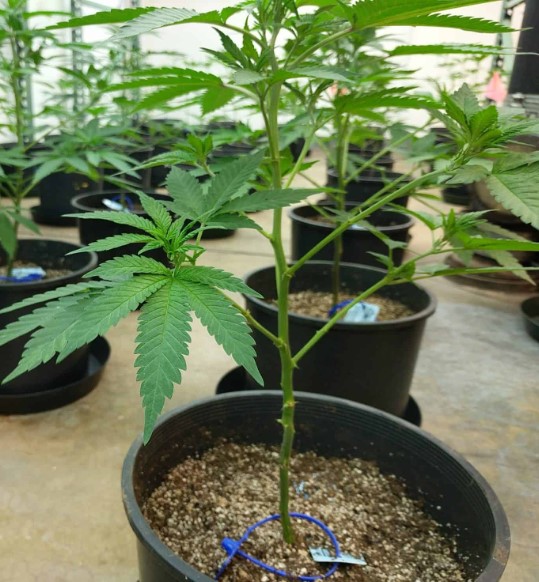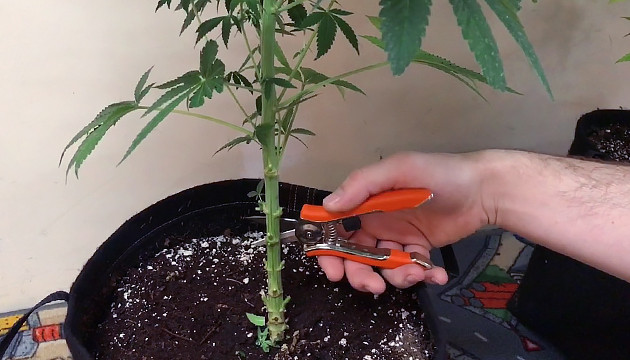Not so long ago, people thought autoflowering cannabis was more fragile and potentially lower-yielding than regular cannabis strains. The usual attitude has been that anything autoflowering can stress and thereby stunt growth. Therefore, defoliating autoflowers was a no-go, as was transplanting and various high and low-stress techniques. Luckily that has changed.
Defoliating autoflowering cannabis has become a standard way of caring for and training these plants, and we’ll show you how and when it should be done. Armed with this guide, you will learn to use defoliation (trimming) of autoflowering strains as a means to achieve larger plants and better bud production and yields.
When and Why to Defoliate Autoflowers?
Defoliating autoflowers should not be viewed as a way of tricking nature. We don’t have to cheat to get wonderful, high-yielding plants. We just recognize a problem and help the plants deal with it. If there is no problem, we leave them alone.
So let’s look at the situations in which you can benefit your autoflowering cannabis plants with defoliation:
Better aeration of the plant.
If you are concerned that there is insufficient air movement in the lower part of the plant or inside, remove the excess foliage. Otherwise, there may be problems with mould growth.
More light exposure.
Probably the main reason for the defoliation of autoflowering plants. Make sure large fan leaves do not shade areas of flowering. And if you do, remove them. Get rid of old leaves.
When a plant has sucked all the juices out of the lower fan leaves, there’s no reason at all to leave them on the branches. If the lower leaves are still green, don’t shade anything or block airflow, then it’s okay to leave them.
Control the growth.
Sometimes one of the top shoots grows too fast and overtakes all the others. One of the ways to stem its growth and allow the rest of the branches to catch up is to defoliate it.
Reduction of general perspiration during drought. We did this in our guerrilla grow days. We prefer to let our outdoor plants grow naturally, but we defoliate more generously during a heatwave. Less foliage means less precious water is lost through the leaves.
Disadvantages of defoliating autoflowers
Each leaf contributes to photosynthesis.
Chemical reactions in the leaves create building materials and energy that can be used elsewhere in the plant. So only defoliate if you feel the benefits of defoliation outweigh the leaf’s contribution to photosynthesis.
Each leaf is a repository of essential elements. So-called mobile nutrients (N, P, K, Mg) can be transported from older leaves to new growth (shoots, leaves, flowers, etc.) as required. So if you notice a deficiency in any of these nutrients, defoliating will only make the situation worse.
Slowed growth due to stress.
Defoliation, pruning, topping – they all produce a surge in jasmonic acid. It’s a type of stress hormone that causes plants to temporarily halt growth and use the stored energy to heal wounds. On the other hand, the right amount of stress can produce just enough jasmonic acid to actually make cannabis more potent, a study suggests.
Risk of hermaphroditism (hermaphrodite formation) due to stress.
It’s not the worst kind of stress that can come from mistakes in growing cannabis, but in weaker genetics, it can be enough to get female plants to produce male flowers (hermies).
These downsides of defoliation aren’t reason enough to ditch it entirely, but you should always make sure that in your case the benefits outweigh the cons. And sometimes you might prefer a slightly less invasive and stressful procedure like leaf tucking.
Intensive defoliation of autoflowering plants as a yield-enhancing technique
So far, we’ve only talked about selective defoliation of autoflowers. We take a critical look at our plant and only remove the leaves that don’t fit our imagination.
Many growers see defoliation (especially intense defoliation) as some sort of magic bullet as if it could somehow automatically turn the plant into a super producer. This view was reinforced by the advent of “schwazzing,” a form of extreme defoliation.
Schwazzing became known through the book Three a Light. The title apparently derives from “three pounds of dry flower per 1000w lamp”. The book describes at which stages in the life cycle of a cannabis plant intensive defoliation should be performed, how many rest days to give the plants between defoliation sessions and what nutrients to give the plants. People love clear and easy-to-follow guidelines like these.
By the way, the “Schwazzing” technique was developed for photoperiod cannabis plants and not for autoflowering strains.
However, some growers are also experimenting with an extreme form of defoliation of autoflowering cannabis. Obviously, they were hoping to find a step-by-step guide that would guarantee bigger yields every time. We’d say it’s wishful thinking because every autoflowering strain is different. In addition, each batch of seeds of each variety and each seed in a batch is different. So it’s a gamble how an autoflowering plant will respond to intense defoliation.
Guidelines that most growers agree on when defoliating autoflowers
- Do not remove more than ⅓ of the fan leaves at a time
- Remove only the leaves that have stopped growing
- Leave at least a week between defoliation sessions
- You can defoliate in the veg stage, but not in the transition to the flowering stage
- It’s okay to defoliate during flowering (week 2-3), but only before stretching (the plant’s stretching) is over
- Never cut leaves in late bloom (about week 8 after germination)
- Defoliation: Selectively Intensive Before harvest
| Defoliation Week | Selectively | Intense | Before Harvest |
| Vegetative Stage | |||
| Week 1 | – | – | – |
| 2 | – | – | – |
| 3 | ✔ | – | – |
| 4 | ✔ | ✔ | – |
| Flowering Stage | |||
| Week 5 | ✔ | – | – |
| 6 | ✔ | ✔ | – |
| 7 | ✔ | ✔ | – |
| 8 | ✔ | ✔ | – |
| Week 9 | – | – | – |
| 10 | – | – | ✔ |
As you can see in the table above, a special case is defoliating an autoflowering plant before harvest. If you do this right before harvesting the plant, or before exposing the plant to a period of darkness before harvest, it’s not really defoliation. It’s more of a form of wet trimming. You’ll be removing any fan leaves at harvest anyway, and it’s often more convenient to do this while the plant is still in the ground.



